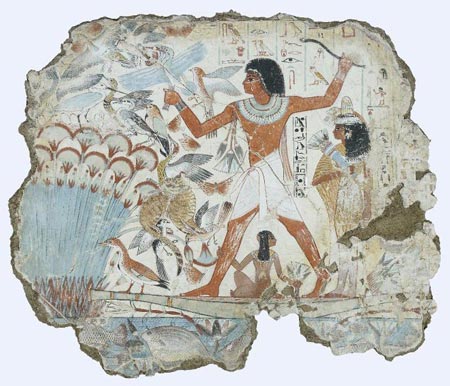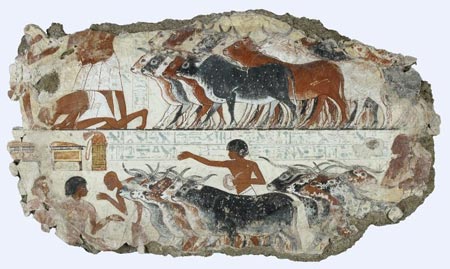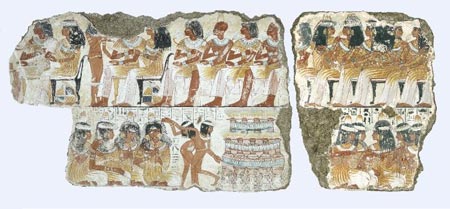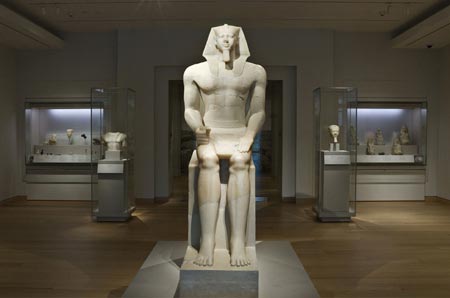The ethical questions of whether ancient works of art should be be conservered or restored are investigated with this resource.
Introduction: Conservation and restoration
Conservation is the practice of preserving the world’s cultural heritage for the future. The techniques and methods of art conservation and restoration go hand in hand and have become the province of trained professionals.
Art restoration denotes the repair or renovation of artworks that have already sustained injury or decay, and the attempted restoration of such objects to something approaching their original undamaged appearance.
Conservation principles
Conservators are highly trained specialists who play a crucial role in preserving archaeological and art artefacts. They work to carefully defined conservation principles that set out a method for thinking systematically and consistently about the values of an artefact. These conservation principles help to group objects according to four categories:
- Evidential value: The potential to yield evidence about past human activity.
- Historical value: The ways in which past people, events and aspects of life can be connected through the object to the present. This is often illustrative or associative.
- Aesthetic value: The ways in which people draw sensory and intellectual stimulation from the object.
- Communal value: The meanings of an object for the people who relate to it, or for whom it figures in their collective experience or memory.
The range of materials can be huge but can be condensed into two types: organic (biological origins, wood, bone and cloth, etc.) and inorganic (mineral origins, stone, metal, and pottery, etc.).
Aspects of conservation
There are four aspects to the area of conservation.
- Examination is the physical and sometimes chemical determination of the nature of the material, the style and provenance (the history of ownership when documented or authenticated and the validity of records or documents authenticating such an object or the history of its ownership).
- Investigation is an evaluative process to determine the condition, purpose, value and appropriate processes needed to maintain the object.
- Restoration aims to return an object to its earlier appearance or condition.
- Preservation is the attempt to maintain materials in their present form and prevent further deterioration.
Conservators perform two kinds of conservation; preventive and interventive. Preventive conservation seeks to preserve the current condition of an object by maintaining a chemically inert environment through the control of humidity, temperature, light and surrounding materials. Interventive treatment is the restoration which takes place when deterioration of an object occurs and needs to be addressed.
Like all professions, conservation engages in a perpetual dialectic with its past, and “best practices” of conservation evolve continually.
During the process of conservation conservators enter a dialogue with their objects, to ask questions such as:
- What is this object made of?
- What was its original appearance?
- What is its history?
- What kind of information can we extract from it, now and in future?
- Is it stable or is it actively deteriorating?
- Why is it deteriorating?
- How can I stop, or even reverse any deterioration?
- How should it be looked after when it has been treated?
- How obvious should the intervention be?
Let’s look at the field of conservation through some case studies of some Egyptian artefacts.
Paintings from the Temple of Nebamun at the British Museum
On the 21st January 2009 the BBC reported that following a 10-year period of conservation and research, the paintings from the Temple of Nebamun would be on display together for the first time.
These paintings are considered to be some of the finest wall paintings to survive from Ancient Egypt and depict an accountant in the Temple of Amun at Karnak, who died in 1350 BCE. They were found in an 18th Dynasty tomb-chapel located in the hills near Luxor, although the exact location of the tomb-chapel remains unknown. They were first acquired by the museum in the 1820-30s and were on display until 1999 when the paintings were removed for conservation and research work.
During the period 2001 to 2007, the fragments of wall paintings were extensively conserved. It was during this work that a piece of dated newspaper was found in the 19th century plaster of Paris mount. Its date showed that the paintings were originally mounted and displayed in the Museum in 1832.
The conservation and repair work, whose primary objective was to re-display the group of eleven paintings, is predicted to allow the painting to be safe for 50 years. The paintings can now be found in a gallery at the British Museum.
The conservation process
The first task was to carry out a full re-examination of the paintings. This was to determine their meaning and to investigate in detail their provenance in order to re-display the paintings as works of art in an appropriate context.
This research was carried out not just on the fragments at the British Museum paintings, since more fragments of the art were in other museums. The Museum collaborated with other museums containing fragments of the paintings, with various institutional and private archives, and with colleagues working in the field at Luxor.
The conservation investigation process started with the dismounting of the paintings on their mud plaster, gesso and painted surface, from the Plaster of Paris support backings applied in the nineteenth century. This provided a rare opportunity to undertake a comprehensive scientific investigation of the materials and techniques of this outstanding group of paintings. The identification of the original materials of the painting’s plasters, pigments and paint media as well as materials applied during earlier conservation/restoration interventions informed the conservation process.
The scientific analysis in the Museum’s laboratories revealed the painters had used a standard palette of pigments, and the aesthetic effects of the paintings were created by assured draughtsmanship and almost unparalleled technical skills. The freedom of the compositions and the lively details make the scenes hugely appealing, and the handling of the textures, especially on the various animals, is remarkable.
While some Ancient Egyptian paintings could be executed directly onto stone, the tomb of Nebamun was situated in an area of weak limestone. The tomb-chapel was roughly cut out of the surrounding rock and the inside lined with mud plaster. This meant the delicate material of the painting started to deteriorate shortly after it arrived in the very different climate of England. Over time a variety of different treatments were used to conserve them. Old plaster mountings were removed using dental equipment. Painted surfaces were consolidated using an acrylic emulsion.
Colours and paint effects
The original painted surfaces, are relatively light resistant so the colour was reasonably good. The Ancient Egyptian painters used a small range of pigments. Lamp soot (C) for the black, and calcium sulfate (CaSO4) and huntite (CaMg(CO3)2) for the white. They also used clay tinted with mineral oxides such as red and yellow ochres. To gain the blues and green they used synthetic materials called Egyptian blue or frit.
They mixed paints to obtain the full palette of colour for the paintings. Different tones were obtained by mixing the paint with the white huntite. A range of reds, yellows and oranges and browns were made by mixing red and yellow ochres with black and white. Upon examination it was clear that some pigments such as those for foliage, have been lost over time, but they could have been made from mixing green and blue frit.
What appeared to be flaking paint was in fact an effect designed to imitate skin seen through a diaphanous linen cloth. This effect was gained by painting first in red, allowing the paint to dry then adding a layer of white huntite and while still wet, it was brushed off. One notable discovery was the gold leaf gilding on the eye of the cat in the Fowling in the Marshes fragment. This is the only known example of gilding on wall paintings in Theban tomb-chapels.



Figure 1: The paintings show the accountant Nebamun at work and at leisure, surveying his estates and hunting in the marshes. © The Trustees of the British Museum
Recording the conservation work
The research will be published and scientific information gleaned during the project will be incorporated into the new display, and presented in a multi-authored volume. To this end the paintings were carefully examined and conserved in order to stabilise the painted surfaces and underlying plaster backings.
Shroud of Ipu from Norwich Castle Museum and Art Gallery
This story starts in 1921 when a large collection of Egyptian artefacts was donated to Norwich Castle Museum. Included in the collection was a folded and very crumpled textile covered with hieroglyphic texts. It remained untouched for around 90 years. Then there was proposed a project by Norwich Castle and the British Museum to study the history of, and conserve, the textile.
This started with the linen being unrolled to ascertain its significance. It soon became clear as it gradually unfolded that it was a rare example of an early 18th Dynasty shroud. Since only around 30 of these are known it was important to determine and explore its history.
Provenance
What was known regarding its provenance was that the shroud was purchased in Egypt in 1897 by Jeremiah Colman, the manufacturer of Colmans’ Mustard, along with over 250 other antiquities. This large collection passed to two of his daughters who made the collection available for study by researchers. Then in 1921 they donated the collection to the City of Norwich and it came to Norwich Castle.
Accompanying the collection was a catalogue compiled by the Egyptologist James Edward Quibell, the discoverer of the Narmer Palette. His catalogue entry for the shroud reads:
‘Linen sheet. Covered with hieroglyphicinscriptions from the “Book of the Dead”. The mummy in thecoffin was often covered with a linen sheet of this kind.’
Hieroglyphs and inscriptions
Examination of the shroud showed it is approximately 3500 years old and has vertical columns of cursive hieroglyphic texts that are written in the same hand. It also has inscriptions containing spells from the Book of the Dead designed to help the deceased person on their journey to the afterlife.
They first investigated the hieroglyphs and found the cartouche of the Pharaoh Menkaure, then among the inscriptions the conservers discovered the name of the shroud’s owner; Ipu, daughter of Mutresti.
Both names were common at the time of the manufacture of the shroud. Ipu’s title is not recorded on the shroud fragment. Other fragments of the shroud were known to exist in the Egyptian Museum, Cairo and these gave Ipu’s title as ‘khekeret nesu’, sometimes translated as the ‘king’s ornament’. The precise meaning of the title is not certain but it is known that it was often held by women of high status.
Conservation and preservation
The examination and investigations concerning the shroud helped the conservation team to make decisions about how to conserve and preserve the shroud.
First the team had to make the shroud’s support board. For that they used a thick, acid free card with a honeycomb structure inside. This makes it a very strong but light, and perfect to use as a large carrying board. The support was covered with a brushed cotton fabric as a slightly soft padding, and on top of that cotton fabric dyed to a neutral beige colour.
The handling and moving of a large, fragmentary and fragile textile is not straightforward so the shroud was put onto a temporary board. It was placed in exactly the position it was to be in on its final support board. It was centred and placed face down on the final support with the edges of the two support boards clipped together. The whole assemblage was turned as quickly as possible.
Then a semi-transparent net, dyed to be nearly invisible once in contact with the textile, was laid over the shroud. The three layers of fabric were secured together with stitches using fine silk thread and curved needles normally used in surgery. Each thread was aligned in the direction of the weave an operation that took over four weeks.
The shroud is now stabilised; having been mounted on a fabric-lined board and secured with a semi-transparent net stitched over it. This has meant that it can be stored and studied safely, and even be displayed and loaned.
Statue of Menkaura Boston Museum of Fine Arts
This story starts in January 1907 when an expedition group from Harvard University and Boston Museum of Fine Arts lead by George Reisner found fragments of an alabaster statue. They were found by George Reisner in a pit in the king’s temple at the base of the third and smallest pyramid at Giza.
It was clear the fragments were from a single block of Egyptian alabaster (travertine) statue that had been broken up a long time ago, but no-one knew why. They had found fragments of the torso and shoulder. Then later they found a large piece that included the hands, legs and throne base. These pieces allowed them to deduce they had found a seated statue of a pharaoh. Two months later the head of the statue was found in a robber’s trench, so it is likely the statue was broken up by robbers in antiquity. It was revealed that the team had a seated statue of Menkaure the fourth Dynasty pharaoh (2490-2472 BCE).
Initial restoration attempts
The fragments were sent back to Boston’s Museum of Fine Arts. This saw the first attempt in 1909 at a restoration of the statue in which the torso fragments were left out. Over the years more attempts were made and in 1911 some torso bits were added. By 1925 the expedition artist, Joseph Lindon Smith had succeeded in linking head, chest and throne base. It was not until 1935 that Smith and Charles Muskavitch completed the restoration. In its restored state it’s nearly eight feet tall. It remained on display to the public until 2010 when it was decided to move the statue to a new gallery.
Examination of the statue
Before the statue could be moved it was decided to conserve it. So it was first examined. It was deduced that the statue originally sat in a niche in Menkaure’s Pyramid Temple. The pose is the traditional sitting pose for royalty; frontal. The statue is looking ahead with a straight posture and arms resting on his thighs with knees close together and feet firmly placed on the ground.
The head is the original and it wears the nemes, the striped head cloth worn by pharaohs in ancient Egypt. The nemes covered the whole crown of the head and went down the back of the head to the nape of the neck. It has two large flaps which hang down behind the ears and in front of both shoulders. In the centre of the nemes sitting on a band, holding the nemes in place is a cobra (ureaus). There are also the chipped remains of a ponytail peeking out from the nemes.
The statue has a symmetrical face with eyes staring straight into the distance. Evidence from the investigation shows they were once painted. The nose is chipped with the tip missing but the nostrils are still present. It has large articulated ears that sit outside the nemes and there is a faint indication of black paint. On the face a thin painted moustache is just visible as is a thin strap that held in place a long, straight beard. The expression is a serious one and one of someone in full command.
Looking at the head, in proportion it appears small in comparison with the rest of the body. This accentuates the height for as you approach the statue and look up at the head it appears to be further away from you then it really is. This artistic device of making the shoulders and torso larger than the head emphasises the position of the king as above all others and dwarfs the viewer.

Figure 2: Colossal Statue of King Menkaure, 2490-2472 BCE, Travertine (Egyptian alabaster), Giza, Menkaure Pyramid Temple. © The Museum of Fine Arts, Boston.
Looking at the main body one is aware that he is a mature powerful man since the muscles of the chest and calves are well defined, he looks youthful and he is at peak condition; in the prime of his life. All he wears on his body is a kilt, this is identified as the royal kilt because of the central fold, and in his right hand he holds a piece of folded cloth. Interestingly the toes include, in fine detail, toenails.
Stabilisation
Part of the conservation process was the move of the statue to a new gallery so the examination and investigation of the statue was followed by the stabilisation of the material of the statue. This involved the use of gamma radiography to visualise the internal structure of the sculpture and to design the apparatus to move the sculpture to its new position.
This examination using gamma radiography indicated that the large, heavy and original stone fragments were not securely joined by pinning. Any losses in the sculpture had been filled with an agglomerate of plaster, metal tubes, and other materials and the base of the throne consisted of solid brickwork built on top of a cement base.
This information meant that although the eight-foot-tall sculpture might have looked strong, it was in fact fragile. Because of the material used to create this restoration it was also very heavy and susceptible to cracking with the vibrations that would accompany the move. It was therefore important to design and build a supporting movable platform.
The examination of the statue and the design of the movable platform meant it took more than two years before it could be relocated. Eventually a steel base support was constructed, with stainless steel braces set into the brick throne and threaded rods tying parts of the modern construction together. The sculpture and support was ready to be lifted onto a special palette. Over the course of a day the whole thing was moved to its new position and set up for public display.
Problem solving
Conservation and restoration can involve problems to be solved that had never been envisaged at the beginning. These three case studies illustrate the need for the careful examination and investigation of the object followed by the restoration and preservation, and that now includes some prediction of expected time before further conservation would be needed under normal conditions.
Wars and natural disasters can also create specific conditions where conservers and restorers must work carefully together to save works of art.
Downloads
Conservation of Egyptian art
PDF, Size 0.23 mb

















